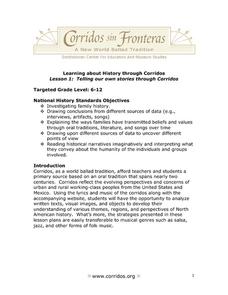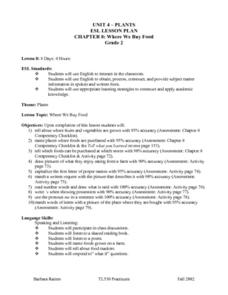Curated OER
Weather Watchers - Interdisciplinary
Students investigate weather and climate through a variety of interdisciplinary activities.
Curated OER
When Distress Spells S.O.S.
Students discover various equipment and technologies used for distress signals, then prepare skits and make recommendations based on information gathered about signaling devices.
Curated OER
Can You Hear a Story?
Learners listen to, analyze, and describe music. They explain relationships between music, the other arts, and disciplines outside the arts.
Curated OER
Understanding Persuasive Writing
High schoolers give examples of how the media glamorize violence and desensitize viewers to the horrors of real acts of violence. They identify factors in addition to the media that contribute to the problem of violence in society.
Curated OER
Inference By Analogy
Students infer the use or meaning of items recovered from a North Carolina Native American site based on 17th-century European settlers' accounts and illustration.
Curated OER
Push or Pull
Young scholars discover that one way to change how something is moving is to give it a push or a pull. They design their own boats and work with 'The Great Boat Push' worksheet to compare how their boats move when they are pushed or...
Curated OER
Passing Down Family History Through Oral Tradition: Corridos
Students create and perform Corridos which are oral tradition ballads. In this Passing Down Family History Through Oral Tradition instructional activity, students interview family members using a predetermined list of questions. In...
Curated OER
The Ancient Maya
Young scholars explore the culture of the Mayans through a variety of activities. In this lesson about Maya, students analyze pictures in books and on websites, produce scale models of Maya architecture, and create Maya mosaics. Young...
Curated OER
Graphing Surveys and Analyzing Data
Students analyze data and graph the results of their surveys. In this statistics lesson, students create graphs using excel to make graphs to be able to better observe their data. They conclude how great we as unique individuals.
Curated OER
Colonial Currency
Fifth graders develop a common currency. For this colonial currency lesson, 5th graders exchange beads, rice, coins, and paper bills for goods and services. Students explore web tools to research ways colonists used money, even if it was...
Curated OER
A Picture is Worth a Thousand Words: How to Analyze a Historic Photograph
Students analyze historical images. In this primary source analysis lesson plan, students examine an photograph of Hershey, PA from the 1920's. Students collaborate with one another and their instructor to note the details in the...
Pennsylvania Department of Education
Freckle Face
Students collect and record data. In this early data analysis lesson, students gather data about their partners face. As a class, the students use tally marks and pictographs to record the data and answer question about the information...
Curated OER
Are We Couch Potatoes or Busy Bees? Data Analysis of Physical Activity in School
Young scholars study practical data analysis within the constraints of the scientific method. In this data lesson plan students collect and enter data into a computer spreadsheet then create graphs.
Curated OER
No Title
Fourth graders identify the characteristics of a good paragraph and find those characteristics in a good paragraph from the books, "One Day in the Woods," by Jean Craighead George and "Why Do Leaves Change Color," by Betsy Maestro.
Curated OER
Why Predict?
Twelfth graders examine the process of predicting. They observe a fine art transparency, discuss their predictions about the artwork, identify the types of predictions made during a weather broadcast, and evaluate headlines from...
Curated OER
Whales
Write factual accounts, reports and express personal viewpoints about whales. They eill also write on a variety of topics related to whales, shaping ideas and making choices in language and form.
Curated OER
Angry Feelings
Students explore how to manage angry feelings. In this behavior instructional activity, students discuss techniques to handle angry feelings, such as counting to ten and talking out the problem.
Curated OER
Autobiographical Writing
Second graders explore, examine and study the style of autobiographical writing and the relationship with the author. They rad three different types of autobiographical writings: narrative, poetry and newspaper article. Each student...
Curated OER
Where We Buy Food
Second graders investigate how to buy food by going to the store. They use pictures of farming and different types of food to engage in the lesson. It includes key vocabulary that puppets use while telling a story to the students. They...
Curated OER
What Makes a Pig Squeal?
Show your charges a Powerpoint presentation about a pig having her hooves trimmed. They discuss what they learned from the pig story and exhibit proper group discussion behavior.
Curated OER
"Math Curse" by Jon Scieszka & Lane Smith
Students use estimation and measurement skills to make predictions and solve problems involving length.
Curated OER
Algebra II: Crickets-Nature's Thermometer
Students translate functional relationships into equations to answer questions. Students answer questions using different representations of the relationships: function rules, graphs of the function, tables of values, and equations and...
Curated OER
State Database Lesson
Fifth graders create a database about the geography of the United States. The access to a computer is essential for this lesson. The outcome is that technology is used as a tool to measure student understanding of geographical locations....
Curated OER
Narrative Writing Outline
Young scholars explore the elements of a narrative for its purpose, type of audience, mood, main character, minor characters, setting, and conflicts in the story. A story outline is developed and a five paragraph essay composed in this...

























